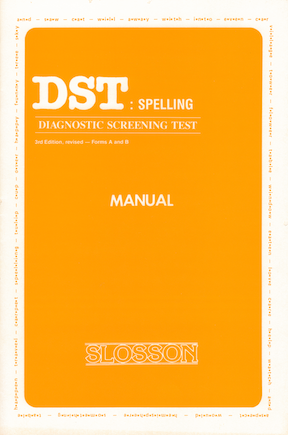Third Edition (DSTR)
Thomas D. Gnagey / Patricia A. Gnagey
Grades: 1 through Junior College
Administration: Individual; 5 to 10 minutes
The DSTR is a quick, valid method for estimating practical data about a student’s reading skills. Designed to assist teachers, psychologists and counselors in quickly obtaining diagnostic information which can be translated into helpful classroom learning activities as appropriate to each student’s individual needs.
An initial pool of 3,221 reading words were obtained by having 71 teachers, Grades 1 through 12, submit lists of up to 100 words typically taught for the first time at their grade level. Seven years of word-sample use helped verify the 84-word range content of the DSTR, yielding four major scores.
Percentile ranks, T-scores, and grade equivalent scores are available for each form (Form A and Form B) and for the two forms combined (Form A + Form B). These scores are also presented for the phonics and sight subtests for each form. Since the sample of 95 students, each in Grades 2 through 8 (average level reading comprehenders), scored essentially identical in reading and listening comprehension, the same norms are used for both (r = .94). Reliability and validity are both quite high for such a short, wide ranging power test.
Diagnostic Screening Test: Reading
Other Subtests (Word Attack Rules):
Sight: Words that do not follow strict laws of
pronunciation must be recognized on sight.
c-vow/c: A vowel usually has the long sound when it comes at the end of a word or accented syllable.
vow/r: In syllables where an “r” follows a single vowel, the vowel sound is usually determined by that “r” sound.
vow/l: In syllables where an “l” follows a single vowel, the vowel sound is usually determined by that “l” sound.
vow-vow: When two vowels come together in a syllable, the first is usually long after the second is silent.
In addition to these basic scales, eight other diagnostic scores reflect skills in phonics, word attack proficiency and sight vocabulary. If mastered, the child would be allowed to attack a vast majority of english reading words.
Order the Entire DST Battery and Save!
Quantity Instructor Discount Available for the DSTR.....Refer to Promos Page
1. Word Reading Comfort Level: the level at which the
student knows almost all of the words and can read each
without any assistance.
2. Word Reading Instructional Level: the level at which the
student knows 85% to 90% of the words and reads easily
enough to gradually acquire the new vocabulary and
associated skills.
3. Word Reading Frustration Level: the level at which the
student is unable to read so many words and therefore
misses the essence of passage and finds the task of
reading uncomfortable or unpleasant..
4. Comprehension of Passage Levels: the level at which
the student is able to understand and remember the facts
and subtleties of passages (Both Reading and Listening
Comprehension are tested).
Summary of the Four Major Scores:
c-vow-c: In syllables having one vowel, it is usually short if not at the end.
Silent e: In syllables having two vowels,
where the final one is “e”, the first is long and
the “e” is silent.
Mix: Assorted Combinations of phonics and word attack rules (Taps overall skill level).
$144.25
43.50
54.00
43.50


















